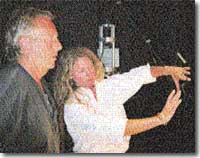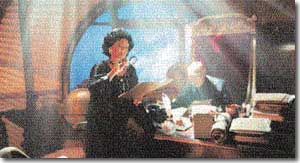| CORPORATE VIDEO |
 |
A Stitch in Time insurance agents laugh and learn
 |
 Writer/director/producer Marta Houske (right) credits director of photography Peter Warrilow (left) with creating A Stitch in Time's big-budget look with a small lighting package. (© MATRIX COMMUNICATIONS, ALL RIGHTS RESERVED) Writer/director/producer Marta Houske (right) credits director of photography Peter Warrilow (left) with creating A Stitch in Time's big-budget look with a small lighting package. (© MATRIX COMMUNICATIONS, ALL RIGHTS RESERVED) |
A Stitch in Time features Nichelle Nichols in the role of an invisible angel who teaches an insurance agent how to avoid unnecessary risks. The comedy short film was written, produced and directed by Marta Houske, Matrix Communications, headquartered in Torrance, California.
Their client, The Cal-Surance Companies, provides malpractice insurance for insurance agents. They wanted to produce and distribute a videocassette designed to make insurance agents aware of the liabilities that result from sloppy paperwork, incomplete phone logs, and even from what they tell and don't tell clients.
"I was pretty blunt," Houske says. "I told them that just another boring instructional video wouldn't accomplish their goals. They challenged me to suggest a better idea. I said, 'How about a comedy?' To my surprise they agreed."
Nichols plays Harvie, an angel from the Bureau of Guardian Angels. She is sent to help Jack, a harried agent, change his bad habits. By the end of the 24-minute program, Jack has learned his lesson and is on the road to being less of a risk.
 |
 Nichelle Nichols—best known as Star Trek's Lt. Uhura—stars as an invisible angel in A Stitch in Time. (© MATRIX COMMUNICATIONS, ALL RIGHTS RESERVED) Nichelle Nichols—best known as Star Trek's Lt. Uhura—stars as an invisible angel in A Stitch in Time. (© MATRIX COMMUNICATIONS, ALL RIGHTS RESERVED) |
The project had a modest budget and it was only going to be released in videocassette format but Houske convinced the client that film gave them a better chance to accomplish their goal of an effective, high-quality video.
"We could have done the easy thing and shot on tape," says Houske, "but I have a long-standing relationship with Cal-Surance that's based on trust and I wanted to do the right thing. This was an important project for them and I felt that we needed to tell an entertaining story so people would watch and remember."
Houske says that the cost of producing on film was only marginally higher and it sent the right message to the cast and crew: This was an important project.
"Fantasy environments and stories are better achieved with film," she says. "Tape has a colder, harder look. It lacks the details and texture you get with film, especially subtleties in faces that help to make the characters come alive for the audience. Film creates a kind of hyper-reality."
The film was shot in 16mm format in just under four days. Director of
Photography Pete Warrilow, was charged with creating a big-budget look with minimal camera and lighting packages.
A key scene takes place in the heavenly Bureau of Guardian Angels. Nichols and the actor playing her superior are bathed in rays of light in a semi-dark atmosphere. Warrilow achieved this effect by bouncing a 4K Xenon light off a cracked mirror, hung overhead.
"It gave us a moody atmosphere which established her character," he says. "For different looks, we adjusted the light source."
The camera package consisted of an Arri SR 16 mm camera and Zeiss prime lenses. He shot with Kodak Vision 200T film.
"You can use a minimum number of lights very effectively if they are positioned correctly," Warrilow explains. "The Vision 200T has great exposure latitude and it holds details in the shadow and highlight areas."
A Stitch in Time has won 16 national/international awards so far including a CINE Golden Eagle and an honor from WorldFest Houston for live action, narrative filmmaking.
"Most corporate clients don't realize that the production values which contribute to successful television shows and movies can also help them get better results from their training programs," Houske says. "I'm convinced the decision to shoot on film lifted everyone's expectations, including the actors and crew, and it resulted in a much more successful program."
|